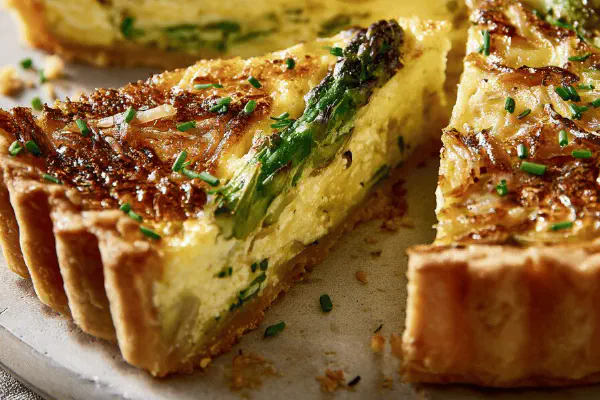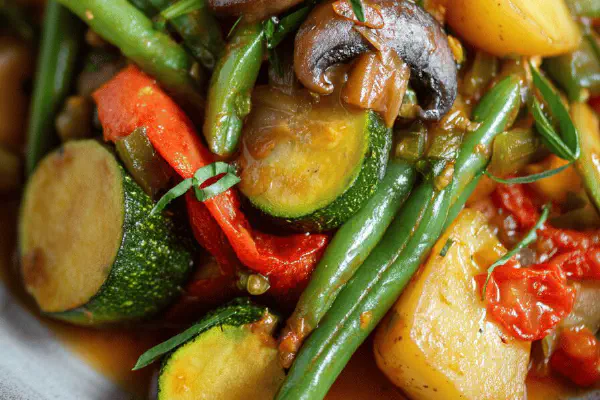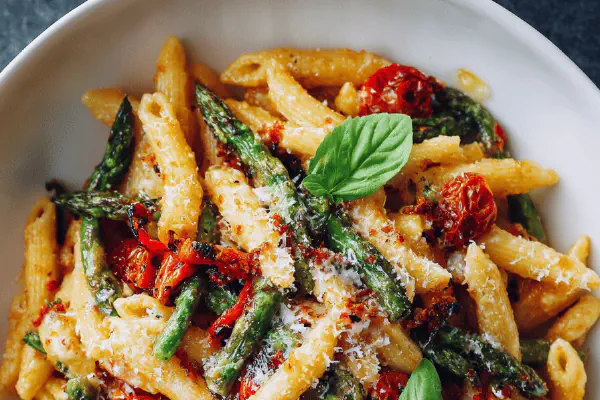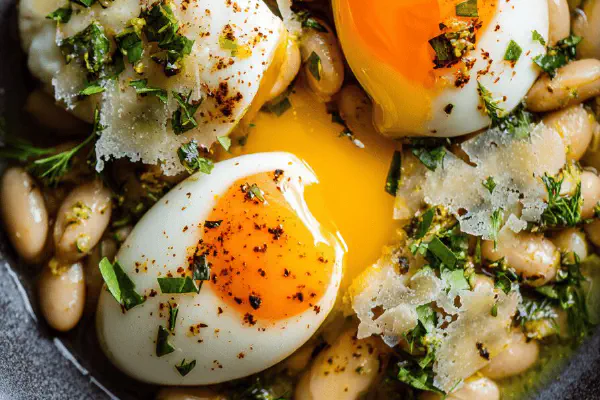Asparagus Gruyère Quiche

By Emma
Certified Culinary Professional
Ingredients
SHORTCRUST DOUGH
- 260 ml all-purpose flour, plus extra for dusting
- Pinch of fine salt
- 110 g cold unsalted butter, diced
- 90 ml chilled water, approximately
FILLING
- 1 medium leek, white and light green parts, thinly sliced
- 30 ml olive oil
- 450 g asparagus, trimmed; tips reserved whole, stalks cut into 2 cm pieces
- 120 ml vegetable broth
- 3 large eggs, beaten lightly
- 200 ml whole milk
- 150 g shredded Gruyère cheese
- Salt and freshly ground black pepper to taste
- Freshly grated nutmeg, optional
- Handful fresh chives, chopped (added twist)
About the ingredients
Method
SHORTCRUST DOUGH
- 1. Pulse flour and salt in food processor to combine. Add cold butter, pulse in short bursts until pea-sized crumbs form — avoid overmixing, or dough gets tough. Add water, one tablespoon at a time, pulsing until dough just clumps together. Dough should feel cool, slightly crumbly but hold when pressed. Wrap tightly in plastic; chill minimum 40 minutes (longer if you can).
- 2. Lightly flour work surface. Roll chilled dough evenly into a 30 cm circle, somewhat thinner at edges. Gentle pressure only — don't stretch dough; will shrink in oven. Ease dough into 23 cm tart pan with removable bottom, pressing into corners without tearing. Trim excess dough. Dock bottom with fork to prevent bubbling.
- 3. Chill lined tart shell again at least 20 minutes to relax gluten and keep shape during blind baking.
- 4. Preheat oven to 185 °C (365 °F), rack in lower third.
- 5. Line dough with parchment paper, fill with pie weights or dried beans. Bake blind 15–18 minutes until edges start to blush golden and firm but center still pale.
- 6. Remove weights and paper carefully. Return shell to oven 5 minutes more, until base is dry and slightly golden but not fully cooked. Cool slightly.
FILLING
- 7. Heat olive oil in heavy skillet over medium. Add sliced leek; soften, stir often ~5 min until translucent and lightly golden, releasing gentle onion aroma. Avoid browning too dark or bitter.
- 8. Add asparagus stalk pieces; sauté 2 min, just losing raw crunch. Season lightly with salt and white pepper.
- 9. Pour in vegetable broth; raise heat slightly, reduce until almost evaporated, about 4–6 minutes. You want tender asparagus, not mushy. Let cool slightly.
- 10. In large bowl, whisk eggs and milk gently. Add grated Gruyère, reserved asparagus tips, leek-asparagus mixture, chopped chives, and a pinch of freshly grated nutmeg if using. Stir well. Taste for seasoning; add salt and pepper incrementally. You want a balanced savory custard, not overly salty.
- 11. Pour filling into pre-baked tart shell. Arrange asparagus tips artfully on top, spaced for even browning and a bit of bite.
- 12. Bake 43–48 minutes at 185 °C. Watch crust edges—if overbrowning, tent with foil. Filling should be just set but still with slight wobble in center when gently shaken. The quiche firms as it cools. Avoid overbaking, or risk rubbery texture.
- 13. Let quiche rest at least 12 minutes before slicing to allow custard to firm properly. Serve warm, room temperature, or chilled. Flavors intensify cooled.
NOTES & TROUBLESHOOTING
- If dough cracks during transfer, patch gently with cold water and patched piece. Keep hands cool to avoid melting butter.
- If custard seems too loose after baking, return to oven 5–7 minutes, or give extra resting time before cutting.
- Substitute whole milk with half milk half cream for richer custard; or use sharp cheddar for stronger flavor but expect slightly different melting.
- Vegetable broth replacement: low-sodium chicken broth or water with pinch of dried herbs works fine for deglazing.
- Leeks can replace onions for milder sweetness; saute low and slow to bring out natural sugars.
- Blind baking prevents soggy crust from wet filling; skip and the bottom will be mushy, trust me learned the hard way.
- Use fresh asparagus; frozen will release too much water and dilute custard; if frozen, thaw and drain thoroughly.
- Leftover quiche reheated gently in low oven retains texture better than microwave which makes crust soggy and custard rubbery.
Cooking tips
Chef's notes
- 💡 Blind bake dough well; flaky, crumbly, not tough. Cold butter key, diced small to pea-size crumbs. Add iced water little by little, stops sticky dough. Wrap and chill dough minimum 40 minutes. Cold dough easier to roll, prevents shrinkage in oven. Use pie weights for blind baking. Remove weights during last five minutes to dry base but not brown fully. Dough cracks? Patch quick with cold water, hands cool to avoid melting butter. Avoid stretching dough under rolling pin; only gentle pressure.
- 💡 Leek softening in olive oil till translucent, light golden, subtle aroma. Avoid browning or bitterness. Timing crucial; around five minutes, stir often. Adds delicate sweetness, less aggressive than onion. Use medium heat, watch sound of sizzle; too loud means too hot. Asparagus stalks added next for just a quick sauté. Don’t cook raw crunch out or get mushy later; two minutes enough. Season lightly with salt and white pepper, balance freshness early.
- 💡 Reduce vegetable broth till nearly evaporated; four to six minutes. Not dry but almost. Key for flavor without soggy custard. Swapping chicken broth works; low sodium best to avoid salty punch early. Watch bubbling sounds and aroma; broth thickens, flavor concentrates. Cool filling mix slightly before adding eggs, cheese, and reserved tips. Nb: avoid over whisking eggs and milk to keep custard silky. Bubbles in batter make holes after baking.
- 💡 Arrange reserved asparagus tips carefully on top of filling before baking. Spread evenly to ensure edges crisp up a little. Watch oven temp 185 °C steady. Bake 43 to 48 minutes; jiggle in center signals nearly done. Edges firm, golden but not burnt. Tent with foil if browning too fast. Custard firms as it cools; cutting too soon risks runny slices. Rest at least 12 minutes to finalize texture. Warm or room temperature serves well; flavors shift but not fade.
- 💡 Reheat leftovers in low oven slow; crust stays crisp, custard creamy. Microwave ruins texture, makes everything rubbery and soggy. If filling runs loose after first bake, put back in oven 5 to 7 minutes; watch edges so no burn. Substitutions: half cream half milk for silkier mouthfeel. Gruyère swap with aged cheddar or comté during supply issues. Fresh chives chopped for bright herbal note, nutmeg optional but gratings add depth. Frozen asparagus to be avoided; excess water ruins balance.
Common questions
How to avoid soggy crust?
Blind baking essential. Use pie weights, parchment paper; bake crust first till edges golden, base dry but pale. Cool before filling. Broth reduction too wet kills crispness. If crust soft, longer blind bake or more thorough drying needed.
What if custard is runny after baking?
Return quiche to low oven, 5-7 minutes increments. Check jiggle in center. Overbaking toughens texture. Custard firms while resting too; patience matters. Mix gently to avoid bubbles causing holes.
Can I substitute Gruyère?
Yes. Aged cheddar or comté good swaps. Texture and melt differ slightly but still rich. Use fresh chives anyway for brightness. Nutmeg optional. Cheese intensity impacts seasoning; taste batter before baking.
Best storage method?
Cover quiche loosely or airtight; fridge for up to 3 days. Reheat in low oven to keep crust crisp. Leftovers good cold even. Avoid microwave unless no choice; ruins custard feel and crust crunch. Can freeze but texture shifts post thaw.



